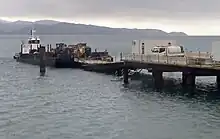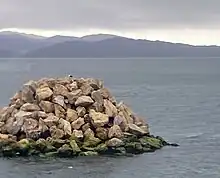Te Ara Tupua is a project to construct a 12-kilometre-long (7.5 mi) safe cycling and walking path in New Zealand, between Melling in Lower Hutt and central Wellington. New Zealand Transport Agency / Waka Kotahi (NZTA) leads the project, with involvement from mana whenua (local Māori groups) Taranaki Whānui and Ngāti Toa, Wellington City Council, Hutt City Council and Greater Wellington Regional Council. The project is divided into three sections: Melling to Petone, Petone to Ngauranga, and Ngauranga to Wellington's central business district. NZTA estimates that by 2030, people will make over 2100 bike trips, 360 walking or running trips and 300 trips on e-scooters on the path each weekday.[1]
Mana whenua involvement
The name of the project, Te Ara Tupua (path of the ancients), derives from the legend of Whātaitai and Ngake, two mythological creatures who fought and in the process created various landforms around Wellington. Points along the cycleway will commemorate former pā sites, locations, and chiefs significant to local Māori, and Māori design concepts will be integrated into the project.[2][3] Te Āti Awa chief Hōniana Te Puni will be commemorated at Honiana Te Puni Reserve at the north end of the Petone foreshore, and his cousin Te Wharepōuri will be remembered in the design of the cycleway bridge over rail tracks at Ngauranga.[2] Two temporary buildings, to be known as Tāwharau Pods, have been built at Honiana Te Puni Reserve. These will act as workshops for master carvers, whose carvings will be used on the path.[4]
Melling to Petone
The section of the path between Melling and Petone is 3.5 kilometres (2.2 mi) long and about four metres (13 ft) wide, and is for cycling only. It was officially opened on 16 October 2023.[5] The path runs alongside an existing rail route and includes two underpasses under the tracks. It links at Petone railway station to the Hutt River Trail, a cycling and walking trail along the river.[6]
Construction was funded by NZTA using the government's Urban Cycleways Fund established in 2014, and Hutt City Council.[5] In 2017, this section of the path was forecast to cost $17 million, but by the time construction began in 2019 the projected cost was $30 million. Poor planning and lack of investigation of the route led to delays and increased costs. $500,000 was budgeted for remediating contaminated land, but that cost ballooned to $4.5 million.[7] Difficulties caused by geotechnical issues and the need to move underground rail and telecommunication utilities led to the final cost increasing to $65 million, making it "one of the most expensive" cycleways in New Zealand at that time.[8]
While cyclists welcomed the path, some were apprehensive about aspects of the design. The path goes through the car park at Petone railway station and passengers leaving the station step directly on to the cycleway.[8]
Petone to Ngauranga

The Petone to Ngauranga section of the path is funded mainly by NZTA, with some funding from Wellington City Council and Greater Wellington Regional Council. As of October 2023, the work is expected to cost $312 million.[9] The shared cycling and walking path will connect to the cycleway from Melling to Petone, and run along the harbour front next to the rail lines from Honiana Te Puni Reserve to the Ngauranga Interchange.[1] Preparatory works began in 2022 and the path is expected to be completed in 2026. This section of the path is 4.5 kilometres (2.8 mi) long and five metres (16 ft) wide. Along the route, six spaces with planted areas will jut out as ūranga or 'landings' for people to pause or use recreationally. The location and design of each landing area relates to the geology beneath it, and each is named after a Māori cultural landmark:[3][10]
- Piki Wahine – a hill above Ngauranga where women and children foraged for foodTahataha Roa – a beach used for landing waka (canoes), which was destroyed in the 1855 Wairarapa earthquake
 Islet of boulders built as a bird habitat.
Islet of boulders built as a bird habitat. - Paroro-rangi Point – formerly a small Te Āti Awa settlement
- Karanga Point – Pari-karangaranga or 'Cliff of Echoes'. Māori are said to have passed along the narrow beach while listening to the voice of a female spirit up in the steep hills.[9]
- Te Ana Bay – Te Ana-puta ('cave opening') is a sacred cave about two kilometres (1.2 mi) north of Ngauranga
- Horokiwi – formerly a settled area and the location of a track over the hills to Takapu Valley and Porirua[11]
Sloping embankments into the water, known as revetments, will protect the path from wave erosion, which has previously been a problem along this part of the coastline. The revetments will be built of boulders or concrete. Six segments of the path will be protected with vertical seawalls instead of revetments, to protect areas of beach gravel that are special habitat areas for birds. Two piles of boulders offshore provide islets for bird life. At Ngauranga there will be a bridge over the railway line, wide and strong enough for emergency vehicular traffic.[1][3] NZTA states that the path will be useful in an emergency, as ambulances or fire engines will be able to travel along it if the road is blocked. As the path is further out from the steep hills along the route, it should be less affected by slips caused by heavy rain or earthquakes that might block the road, and would be able to provide continued access between Wellington and the Hutt Valley.[1]
Construction began in March 2023 with creation of the islets for birds and a temporary wharf at Karanga Point for unloading supplies. The wharf will be removed after the project is completed.[9]
Ngauranga to Wellington CBD
The Ngauranga to central Wellington section of Te Ara Tupua is planned to run from the Ngauranga Interchange, along Hutt Road and Thorndon Quay to Bunny Street near Wellington railway station.[12] Parts of the Hutt Road have had upgraded walking and cycling paths built, and other changes were planned by Let's Get Wellington Moving (LGWM), an organisation controlled by the Greater Wellington Regional Council, Wellington City Council and NZTA. Changes planned for Thorndon Quay have proved controversial. In 2021, the number of car parks was reduced by 50%, which led local businesses to complain that the plan was not well thought out and that they were losing customers.[13][14] Further changes to car parking, installation of cycle lanes, bus priority lanes, and more pedestrian crossings are planned in the final design, with construction beginning late in 2023.[15] In June 2023, LGWM advised Wellington City Council that the cost of the works on Thorndon Quay had increased from $77m in February 2022 to $94m. The increase was due to more detailed designs, scope change and inflation.[16]
NZTA is funding 51% of the project, with the remainder of about $46m funded by Wellington City Council.[16]
See also
- Te Aka Ōtākou, a similar cycleway in Dunedin, New Zealand
References
- 1 2 3 4 "Ngā Ūranga to Pito-One". Waka Kotahi NZ Transport Agency. Retrieved 24 November 2023.
- 1 2 "Mana whenua partnership". Waka Kotahi NZ Transport Agency. Retrieved 23 November 2023.
- 1 2 3 "Resilient Pathway : Ngā Ūranga ki Pito-One". Isthmus. Retrieved 24 November 2023.
- ↑ Boyack, Nicholas (21 March 2023). "Why a $312 million cycleway is a game changer for Wellington". Stuff. Retrieved 24 November 2023.
- 1 2 "Cycleway completion a significant milestone for Te Ara Tupua". Waka Kotahi NZ Transport Agency. Retrieved 23 November 2023.
- ↑ "Pito-One to Melling". Waka Kotahi NZ Transport Agency. Retrieved 23 November 2023.
- ↑ Pennington, Phil (20 June 2022). "Documents reveal poor planning, investigation to blame for budget blowout on Petone cycleway". Newshub. Retrieved 23 November 2023.
- 1 2 Boyack, Nicholas (24 October 2023). "'Wolves and mice' and a penny-farthing on $65m cycleway". The Post. Retrieved 23 November 2023.
- 1 2 3 Boyack, Nicholas (31 October 2023). "Temporary wharf paves the way for harbour resilience". The Post. Retrieved 25 November 2023.
- ↑ Proposed Wellington City District Plan – Consolidated Officer Chapter – Recommendations (PDF). Wellington City Council. 18 July 2022. p. 3.
- ↑ "6. Culture and history". Northern Reserves Management Plan (PDF). Wellington City Council. August 2008. p. 68.
- ↑ "Project: Te Ara Tupua". Australia New Zealand Infrastructure Pipeline. Retrieved 25 November 2023.
- ↑ "Petition signers fight to retain carparks in Wellington's Thorndon Quay". RNZ News. 15 December 2021. Retrieved 25 November 2023.
- ↑ "Council failed to consider all practical options for Thorndon Quay parking, collective says". Stuff. 1 June 2023. Retrieved 25 November 2023.
- ↑ "Thorndon Quay businesses concerned about disruption during cycleway construction". Wellington Scoop. 19 October 2023. Retrieved 25 November 2023.
- 1 2 Hunt, Tom (25 June 2023). ".... And then another $17m got added to a Let's Get Wellington Moving project". Stuff. Retrieved 25 November 2023.